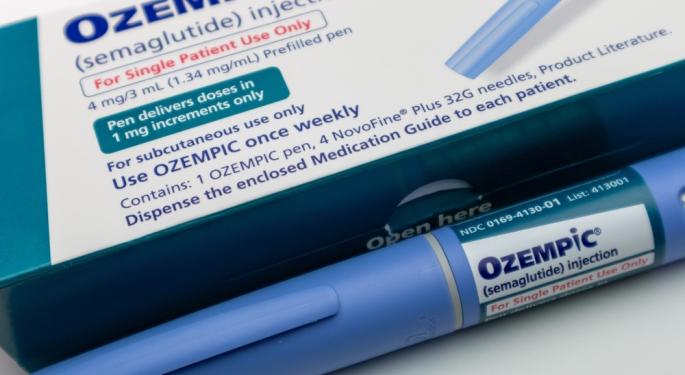Ozempic, Mounjaro Users Cut $6.5 Billion From Grocery Bills: GLP-1 Boom Triggers Panic In Packaged Food Aisles
GLP-1 medications are delivering a $6.5 billion blow to U.S. grocery spending, with weight-loss drugs fundamentally altering consumer food purchasing patterns across America’s retail landscape.
What Happened: Big Chalk Analytics reports that users of glucagon-like peptide-1 receptor agonists, including Novo Nordisk A/S‘s (NYSE:NVO) Ozempic and Wegovy alongside Eli Lilly and Co.‘s (NYSE:LLY) Mounjaro and Zepbound, have significantly reduced their grocery expenditures.
The firm’s survey of 4,500 consumers reveals an additional 8.3% of Americans plan to start these medications, potentially triggering $4.4 billion to $10.8 billion in further grocery losses.
Currently, 11.2% of U.S. adults use GLP-1 medications, with penetration potentially reaching 20% within twelve months. The drugs have generated grocery volume losses between 1.2% and 2.9%, while dollar sales dropped 0.9% to 2.3% across categories, according to Big Chalk’s analysis.
“GLP-1s have crossed the household-penetration threshold where their impact on grocery volumes and dollar sales can no longer be ignored,” said Rick Miller, partner at Big Chalk Analytics. “This is measurable, structural change.”
Why It Matters: The appetite-suppressing effects have reshaped purchasing behavior across key categories. GLP-1 users demonstrate 65% higher likelihood of buying smaller cereal packages, 48% preference for reduced lunch meat portions, and 36% inclination toward smaller soft drink sizes.
“If grocery stores are seeing volume drops, we should expect lower prices under normal supply-demand dynamics,” Kevin Thompson, CEO of 9i Capital Group, told Newsweek. “That’s not materializing yet.”
The pharmaceutical sector faces additional headwinds as the Trump administration considers up to 200% tariffs on drug companies. Barclays warns such levies would “inflate production costs, compress profit margins, and risk supply chain disruptions,” particularly impacting Novo Nordisk given its Danish manufacturing base for Wegovy’s active ingredients.
Long-term adherence data reveal sustainability challenges, with only 8.1% of patients maintaining GLP-1 obesity therapy after three years, though one-year Wegovy persistence improved from 33.2% in 2021 to 62.7% in 2024.
Read Next:
Disclaimer: This content was partially produced with the help of AI tools and was reviewed and published by Benzinga editors.
Photo by KK Stock via Shutterstock
© 2025 Benzinga.com. Benzinga does not provide investment advice. All rights reserved.
Posted-In: Health Care Markets



